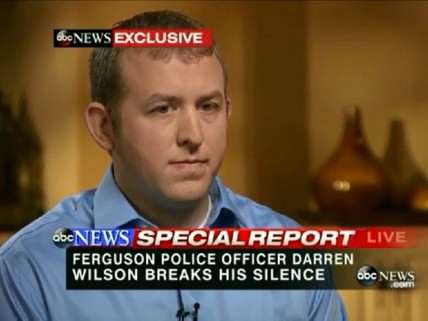Darren Wilson Denied Shooting at a Fleeing Suspect Yet Offered a Justification for Doing So

In my column last week, I noted that the Missouri statute governing the use of force by police clashes with restrictions imposed by the U.S. Supreme Court. That issue came up during the deliberations of the grand jury that rejected criminal charges against Darren Wilson, and it may have shaped his testimony.
Missouri's law allows police to use lethal force if they reasonably believe it is "immediately necessary" to effect the arrest of someone who has "committed or attempted to commit a felony." That's a remarkably broad license to kill—broad enough to justify, say, shooting at a suspected pot dealer who otherwise might get away. In the 1985 case Tennessee v. Garner, by contrast, the Supreme Court said shooting at a fleeing suspect is permitted only when he "poses a threat of serious physical harm, either to the officer or to others."
Assistant St. Louis County Prosecuting Attorney Kathi Alizadeh pointed out this conflict to the grand jury. "What we have discovered," she said on November 21, "is that the statute in the State of Missouri does not comply with the case law." Alizadeh told the grand jurors they should therefore disregard the statute and judge Wilson's shooting of Brown according to what the Supreme Court has said the Fourth Amendment requires.
The Court's ruling in Garner also seems to have been on Wilson's mind when he testified before the grand jury on September 16:
One thing you guys haven't asked that has been asked of me in other interviews is, was he a threat, was Michael Brown a threat when he was running away. People asked why would you chase him if he was running away now.
I had already called for assistance. If someone arrives and sees him running, another officer and goes around the back half of the apartment complexes and tries to stop him, what would stop him from doing what he just did to me to him or worse, knowing he has already done it to one cop. And that was, he still posed a threat, not only to me, to anybody else that confronted him.
Although Brown was unarmed, he had, by Wilson's account, just launched an unprovoked assault on a police officer, hitting him in the face twice through the window of his patrol car. Wilson said he feared Brown might hurt someone else he encountered as he was fleeing. That explanation, which Wilson volunteered to the grand jury without being asked, closely tracks Garner's requirement that a fleeing suspect pose "a threat of serious physical harm, either to the officer or to others," before the use of lethal force can be justified.
That's a bit puzzling on the face of it, because Wilson repeatedly denied using lethal force against a fleeing suspect. He said he fired at Brown in the street only after Brown turned and charged, at which point he was acting in self-defense. But according to PBS NewsHour's tally, a dozen eyewitnesses said Wilson fired at Brown while he was running away. One of those witnesses changed his mind on that point in a subsequent interview, and three others agreed that Wilson did not fire until Brown turned to face him. Wilson's testimony about the threat Brown posed to "anybody else that confronted him" may have been aimed at assuaging the concerns of jurors who believed the first set of witnesses.


Show Comments (100)